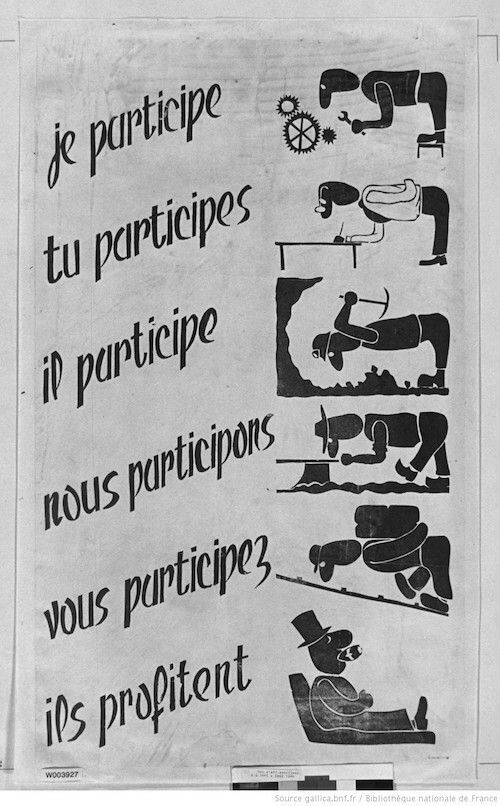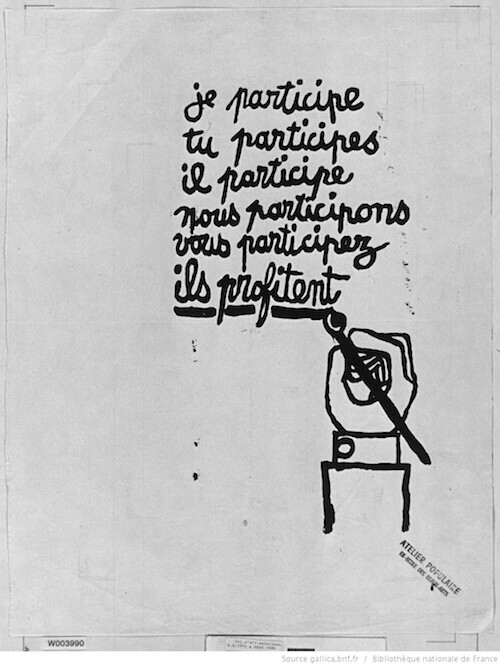Participation without power and property in new governance models

Everybody wants more participation, not less. But the current social project for Europe ultimately offers a kind of feeble, diluted participation that we will affectionately call le objet petit p: a participation without effective decision-making powers, that does not affect social property relations. An ancient form of collective property still practiced in Northern Italy suggests what participation should be instead.
The last three or four decades have seen a clear normative trend towards a shift from ‘government’ (hierarchy, principal–agent) to ‘governance’ (networks; partnerships with the private and civic sector, participation): a non-hierarchical mode of coordination between public, private and civic actors and between different public actors themselves (Shearing and Wood, 2003; Wood et al., 2011). This trend comprises the following central elements: first, instrumental rationality, which prioritises effectiveness, cost-efficiency, problem-solving, technical solutions, over reflexivity.
Second, democratisation as a devolution of responsibility for the definition of principles and of the means to achieve them. Participation, together with joint action and representation (putting issues of concern to stakeholders on the political agenda), becomes a procedural aim within an increased focus on both process and outcome. The inherent potential in the combination of instrumentalist rationality and democratising turn conjures visions of neoliberal paradise: ‘transformative democratic strategies that can advance […] egalitarian social justice, individual liberty combined with popular control over collective decisions’ (Fung, 2001).

Together with the vaunted benefits of the new approach, it is important to stress that good governance requires a set of rather demanding preconditions (Martens, 2007), like a strong, functionally differentiated, well-organised civil society. Another crucial requirement is a government that has a strong institutional capacity, is legitimised and ready to step in (as safety net, provider of last resort, not only as regulator). Eventually the horizontal and decentralized networks of governance can work their magic only ‘in the shadow of hierarchy’ (Héritier and Rhodes, 2011). These are rather strong assumptions, to put it mildly, considering that the capabilities of the ‘hierarchy’, the state machinery, have been systematically axed as part of various packages of ‘structural adjustment’.
With the neoliberal turn from government to governance, from passive social protection to active citizenship, the citizens of contemporary European polities have never enjoyed such a latitude of venues of participation to have their voices heard, their views taken into account (Rhodes, 1996; Shearing and Wood, 2003; Bovaird, 2005; Martens, 2007; Offe, 2009; Sloan and Oliver, 2013). However, the new ‘light’, regulating-not-owning, service-coordinating-not-providing, governance-open government is still rather expensive and extracts a fair amount of resources from households and companies (Offe, 2013). Part of the state revenues is spent on recruiting an army of new social engineering specialists whose job is to ‘activate’ the citizenship, creating the spaces and institutional venues where they can participate. After creatively and passionately labouring in start-up companies, the new model citizen will answer to a higher call and moonlight as a city planner when called upon to join participatory urbanism designing new developments. The following month, she will don the wig as a member of a jury or as part of a community of care in a restorative justice circle. A few days later, he will turn into a public health specialist when scrutinising the local hospital practices to ensure that patients’ rights are properly upheld. All this, it goes without saying, as voluntary work happily contributed out of civic duty for the common good, while facilitated by well-remunerated professional ‘activators’.
If participating is definitely important, the sensation that the actual decisions are being taken elsewhere and that it’s impossible to ‘win’ because the deck is stacked, still lingers on. Even in its heyday during the cultural revolutions of the late 1960s, participation’s ambivalence was patent to observers, as famously engraved in some posters plastered on Paris walls in May 1968:

Linguistically, there is a fecund semantic ambivalence built into the idea of participation. To participate evokes the idea of taking (a) part: it may refer to the part that is assigned or given to somebody, separating it from the whole, or the part that is joined with the others in order to reconstitute a whole. The very divisive action of cutting something into parts creates an implicit bond, inasmuch as the parts are still perceived and constructed as belonging to a unity.
It means to divide and share at the same time, a semantic richness that is well illustrated by the partecipanze agrarie in northern Italy. These are an ancient form of collective property of agricultural land originating in the Middle Ages and still in use in northern Italy (Emilia, Veneto). Powerful abbeys leased as emphyteusis some of their lands to ‘participating’ peasant families, usually after carrying out major drainage works. Even if the nominal property of the land remained with the abbey, with the exception of the small emphyteutic fee and the commitment to take care of the land improving it, the participants enjoyed full ‘possession’, such as access to and control of the land and its produce. The participants retained full, collective decision-making powers regarding cultivations, organisation of works, sharing of produce and so on. Crucially, in this case participation refers to taking part in the undivided property of the land where the part cannot be separated from the whole (Bassanelli, 1979). This ancient arrangement of collective property survived in practice across the centuries into modernity, despite the various attempts of law-makers to stamp them out starting early in the 20th century. The residual nature of the few participatory arrangements that survived is revealed in that they do not find in any of the many legal forms of property that are on offer in the Civil Code. Under contemporary Italian law they are regulated as ‘moral entities’. Since the partecipanze agrarie literally define participation in terms of social property relations, they provide us with a clearer focus to critically re-examine the connection between participation and ‘ownership’ of resources in new governance models.
A further example of the characterisation of participation in terms of ownership and decision-making powers can be found in Arnstein’s seminal article (1969) on the ladder of active participation. Arnstein defined participation as:
a categorical term for citizen power. […] It is the strategy by which the have-nots join in determining how information is shared, goals and policies are set, tax resources are allocated, programs are operated, and benefits like contracts and patronage are parcelled out.
— Arnstein, 1969, p. 217
This amounts to a sort of checklist for determining the level of participation, looking at the actual decision-making power of the partners on the key passages of public policy making and implementation. These levels are schematically represented in Arnstein’s ladder of citizens’ participation, going from ‘manipulation’ and ‘therapy’ as baseline non-participation, to intermediate forms of ‘token’ consultation, to partnerships and higher forms of full citizen control.
If we look at (multi-stakeholder) partnerships as the signature format of new governance implementation, they are higher up in Arnstein’s ladder because in a partnership ‘power is in fact redistributed through negotiation between citizens and powerholders’ (1969, p. 221). But there are some conditions to be fulfilled: partnership can work most effectively when
there is an organised power-base in the community to which the citizen leaders are accountable; […] when the citizens group has the financial resources to pay its leaders reasonable honoraria for their time-consuming efforts; […] and when the group has the resources to hire (and fire) its own technicians, lawyers, and community organisers.
— Arnstein, 1969, p. 221, emphasis added
Like the participants in the agrarian collective property arrangements, Arnstein’s communities should be entitled to substantial decision-making powers and the resources to make them effective. These high standards of a participation with power and property are hardly met in new governance models. Quite the contrary, the new social project for Europe ultimately seems to envisage a kind diluted participation, that we will affectionately call le objet petit p, a participation atomised at the individual level, without effective decision-making powers and that does not affect social property relations.
References
Arnstein, S. R. (1969). A Ladder of Citizen Participation. JAIP, 35(4), 216–224.
Bassanelli, L. (1979). Le partecipanze agrarie emiliane. Milano: Angeli.
Bovaird, T. (2005). Public governance: balancing stakeholder power in a network society. International Review of Administrative Sciences, 71(2), 217–228. doi:10.1177/0020852305053881
Ferrari, V. (1990). Socio-legal Concepts and their Comparison. In E. Øyen (Ed.), Comparative Methodology: Theory and Practice in International Social Research (pp. 63–80). SAGE Publications.
Fung, A. (2001). Deepening Democracy: Innovations in Empowered Participatory Governance. Politics & Society, 29(1), 4–41.
Héritier, A., & Lehmkuhl, D. (2008). Introduction: The Shadow of Hierarchy and New Modes of Governance. Journal of Public Policy, 28(1), 1–17.
Héritier, A., & Rhodes, M. (2011). New Modes of Governance in Europe: Governing in the Shadow of Hierarchy. Palgrave Macmillan.
Martens, J. (2007). Multistakeholder Partnerships – Future Models of Multilateralism? (No. 29). Berlin: Friedrich-Ebert-Stiftung.
McCold, P., & Wachtel, T. (2002). Restorative justice theory validation. In E. G. M. Weitekamp & H.-J. Kerner (Eds.), Restorative Justice: Theoretical foundations (pp. 110–142). Willan Publishing.
Offe, C. (2009). Governance: An “Empty Signifier”? Constellations, 16(4), 550–562. doi:10.1111/j.1467-8675.2009.00570.x
Offe, C. (2013). Democratic Inequality in the Austerity State. Juncture, 20(3), 178–185. doi:10.1111/j.2050-5876.2013.00751.x
Pishchikova, K., Mele, V., Croci, C., Greene, O., Lewis, D., Bartolucci, V., … Vivona, M. (2010). Multi-Stakeholder Partnerships in Post-Conflict Reconstruction: The Role of EU: Theoretical & Methodological Framework. Multipart project.
Rhodes, R. A. W. (1996). The New Governance: Governing without Government. Political Studies, 44(4), 652–667. doi:10.1111/j.1467-9248.1996.tb01747.x
Shearing, C., & Wood, J. (2003). Nodal Governance, Democracy, and the New “Denizens.” Journal of Law and Society, 30(3), 400–419.
Acknowledgements
Photos: [Mai 1968]. Je participe, tu participes, il participe, nous participons, vous participez, ils profitent [affiches] Biblioteque National de France
This post presents ideas included in the book chapter “Critical reflections on active participation under new governance models” that I co-authored with Christa Pelikan (but the responsibility for this post is mine only), part of Ivo Aertsen and Brunilda Pali (eds.), Restoring Justice and Security in Intercultural Europe, Routledge, 2017.
Originally published on Security Praxis



